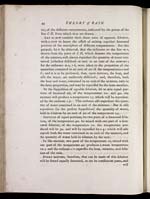James Hutton (1726-1797)
Theory of rain
44
THEORY of RAIN.
air, of the different temperatures, indicated by the points of the
line C H, from which they are drawn.
LET us now consider these three rates of aqueous solution,
with a view to know the effect of mixing together saturated
portions of the atmosphere of different temperatures. For this
purpose, let it be observed, that the ordinates to the line m r,
drawn from the point of C H, which denotes the temperature
of the mixture, will always represent the quantity of water con-
tained (whether dissolved or not) in an unit of the mixture;
for the ordinates m a, r b, were taken in the proportion of the
quantities contained in an unit of air of the temperatures a and
b; and it is to be presumed, that, upon mixture, the heat, and
also the water, are uniformly dissolved; and, therefore, both
the heat and water, contained in an unit of the mixture, vary in
the same proportion, and may be expressed by the same measure.
IN the supposition of equable solution, let us mix equal por-
tions of saturated air, of the temperatures 10. and 40. the
mixture will produce a temperature 25. which, will be represent-
ed by the ordinate o p. This ordinate also represents the quan-
tity of water contained in an unit of the mixture. But it also
represents (in the present supposition) the quantity of water,
held in solution by an unit of air of the temperature 25.
INSTEAD of equal portions; let two parts of a saturated solu-
tion, of the temperature 40. be mixed with one part of a satu-
rated solution, of the temperature 10. the temperature pro-
duced will be 30. and will be expressed by u q; which will also
express both the water contained in an unit of the mixture, and
the quantity of water held in solution by the unit.
IN like manner, two parts of the temperature 10. mixed with
one part of the temperature 40. produces a mean temperature
20.; and the ordinate c n expresses the heat, mixture, and solu-
tion of the unit.
EVERY mixture, therefore, that can be made of this solution
will be found equally saturated, as are its constituent parts, and
will


